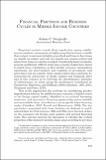| dc.description | Empirical analysis reveals three regularities among middleincome countries: consumption is highly procyclical and more volatile than output, investment is highly procyclical and three to four times as volatile as output, and real net exports are countercyclical and about three times as volatile as output. Standard dynamic stochastic general equilibrium (DSGE) small open economy models have failed to match these regularities, as they predict excessive consumption smoothing, low procyclicality and volatility of investment, and procyclical real net exports. Some studies tackle these problems by increasing the persistence of shocks (Aguiar and Gopinath, 2004 and in this volume) or by lowering the intertemporal elasticity of substitution, as when using the preferences introduced by Greenwood, Hercowitz, and Hoffman (1988) (Mendoza, 1995, 2001, Neumeyer and Perri, 2005). | |


